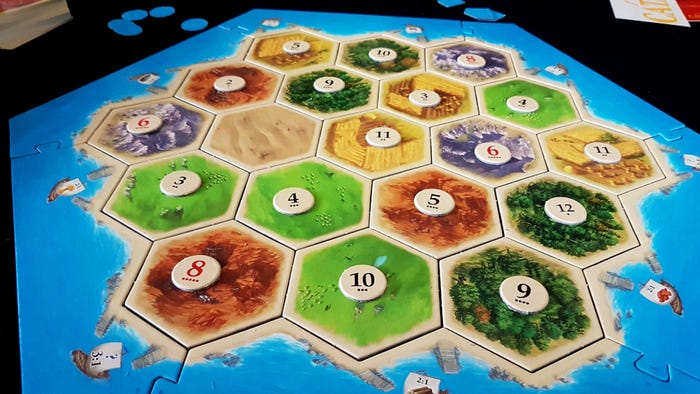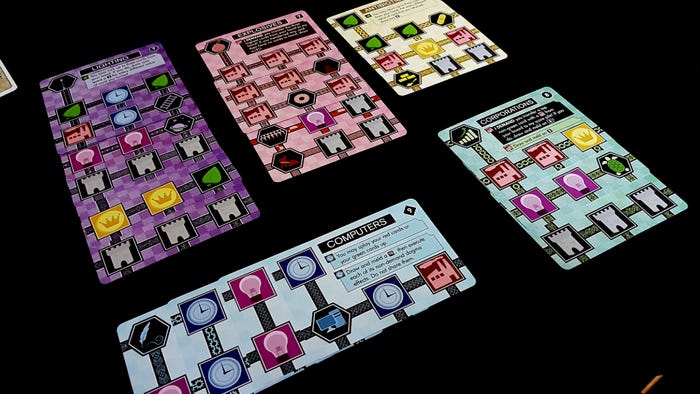Book Excerpt: Tabletop Game Accessibility: Meeple Centred Design
'This book contextualises this practical guidance within a philosophical framework of how the relatively abled can ethically address accessibility issues within game design.'
May 9, 2024

The following excerpt is from Tabletop Game Accessibility: Meeple Centred Design by Dr. Michael James Heron. The book was published April 12, 2024 by CRC Press, a division of Taylor & Francis, a sister company of Game Developer and Informa Tech. Use our discount code GDTF20 at checkout on Routledge.com to receive a 20% discount on your purchase. Offer is valid through July 4, 2024.
The Continual Reinvention of User Experience
I genuinely believe that accessibility in board games is the single most interesting usability problem domain that exists. It’s a completely different beast from video game accessibility. Just as inaccessibility is bound up in fun, complexity of inaccessibility is an unavoidable side effect of what a board game is. Within video game accessibility, we have some constants that make life easier. We know how to make accessible video games, by and large. I won’t say it’s a solved problem because we see every year that there is still work to do. But it is a solvable problem because we know the size and boundaries of the problem domain. A video game comes with a control scheme (keyboard/mouse, controller, motion control wand, whatever) and an output system (monitor, speakers, virtual reality [VR] headset – again, whatever). For a given system, 99% of the games that are played will use these interface features in the same way. The exact specifics of consequence will change from game to game, but you move a joystick, you click a button, and you look at a screen. ‘The exact specifics’ contain complexities, for sure. But at least you can make some assumptions and that allows for things like the Xbox Adaptive Controller, remappable control schemes, and all the genuinely great guidance to be found in the Game Accessibility Guidelines2. There is consistency. We don’t have that luxury with board games. Every single board game reinvents its interface anew. There might be shared features or informal conventions, but the innovation of a board game is often tied up in the novelty of its interface. Games may share a common component list (dice, tiles, cards, and tokens) and still have no commonality in how those components are used. Tiny Epic Galaxies (Figure 1.1) uses a set of custom dice that are used as a currency for actions that may be taken in a round. Archaeology – The New Expedition (Figure 1.2) has relatively standard cards – some played to the table and some held in hand.

FIGURE 1.1 Some of the pieces in Tiny Epic Galaxies. (Photograph by the author.)

FIGURE 1.2 A hand of cards in Archaeology: The New Expedition. (Photograph by the author.)

FIGURE 1.3 A pile of tokens for Race for the Galaxy. (Photograph by the author.)
Race for the Galaxy (Figure 1.3) has a fixed set of scoring tokens – you add these to the score attained by playing cards at the end and sum up to find your final point tally. Catan (Figure 1.4) has a modular board made of tiles, where their relative fecundity is determined at setup with randomly assigned numbers. Dice, cards, score tokens, and tiles. All used in one way to create the game interface. But ...

FIGURE 1.4 Catan, the board laid out for future exploitation. (Photograph by the author.)

FIGURE 1.5 Lords of Vegas. (Photograph by the author.)
Lords of Vegas (Figure 1.5) uses dice as area control as much as for generating random numbers. The ownership, value, and meaning of these dice (and the tiles in which they are embedded) will all change constantly through the course of the game.

FIGURE 1.6 Some of the tokens in Tigris and Euphrates. (Photograph by the author.)

FIGURE 1.7 Cards in Innovation. (Photograph by the author.)

FIGURE 1.8 Tiles in Hive. (Photograph by the author.)
Tigris and Euphrates (Figure 1.6) has chips for scoring just like Race for the Galaxy. But you don’t add the points to your tally at the end – you get the points from the category of score in which you have the smallest number of chips. With Race for the Galaxy, you can just look at your chips and know what they mean. Tigris and Euphrates has ownership of chips as a kind of elastic game mechanism of progress. The combination you hold will influence the way you play the game. You don’t need to get ‘more’; you need to get ‘more of the one of which you have fewest’. Innovation (Fig u re 1.7) makes use of cards, but the direction in which they are splayed (as in, how they are fanned out) has huge gameplay impact because it changes which symbols on which cards are visible and thus how many of those symbols you have access to in order to fund game actions. This splaying system is fun, and interesting, but certainly ‘non-standard’ as far as the use of cards in games goes. Hive (Figure 1.8) shares features with Catan in that it has a modular board made of tiles. However, this board will shift and move, slithering across the table in response to the decisions taken by each player. Its size, shape, and configuration are all going to evolve over play like insects crawling over each other in a ... well, a hive. Catan’s board is fixed. Hive’s board is forever shifting. Dice, cards, score tokens, and tiles. Each game uses them differently, and it is in this variety of experience and utility that we find the joy – and difficulty – in tabletop gaming. Games exist that use egg-timers (such as Kitchen Rush) and that make use of scratch-and-sniff cards (the Perfumer). There are games that use marbles (Gizmos and Potion Explosion), games with meeples that you place on boards (Village), and games with meeples you balance on top of other meeples (Meeple Circus). There is no end to the way in which games will vary the way you use their components. Within board game accessibility, we can’t even rely on the anchor of how a game interface works.
You May Also Like





.jpeg?width=700&auto=webp&quality=80&disable=upscale)



.jpg?width=700&auto=webp&quality=80&disable=upscale)




